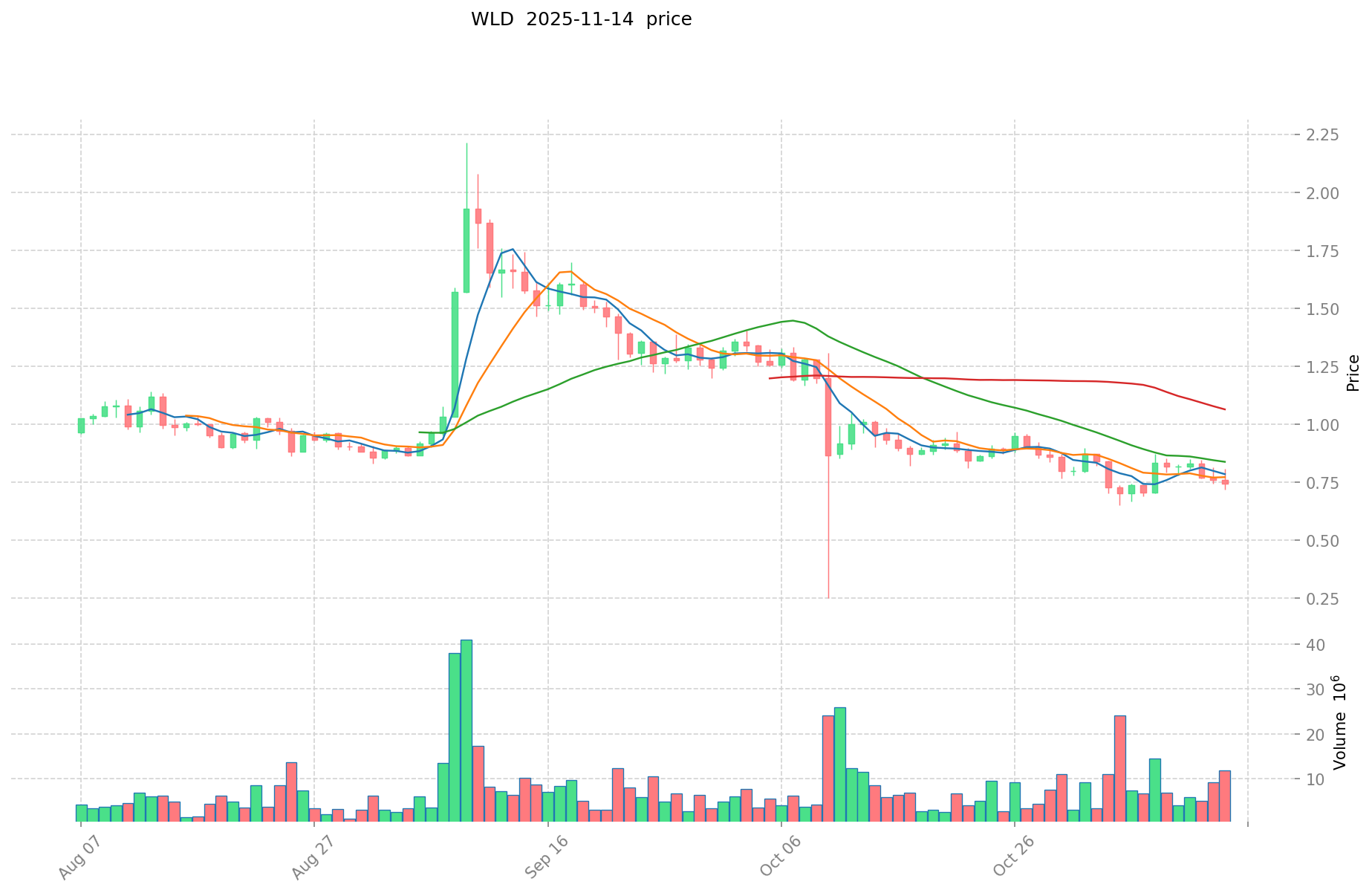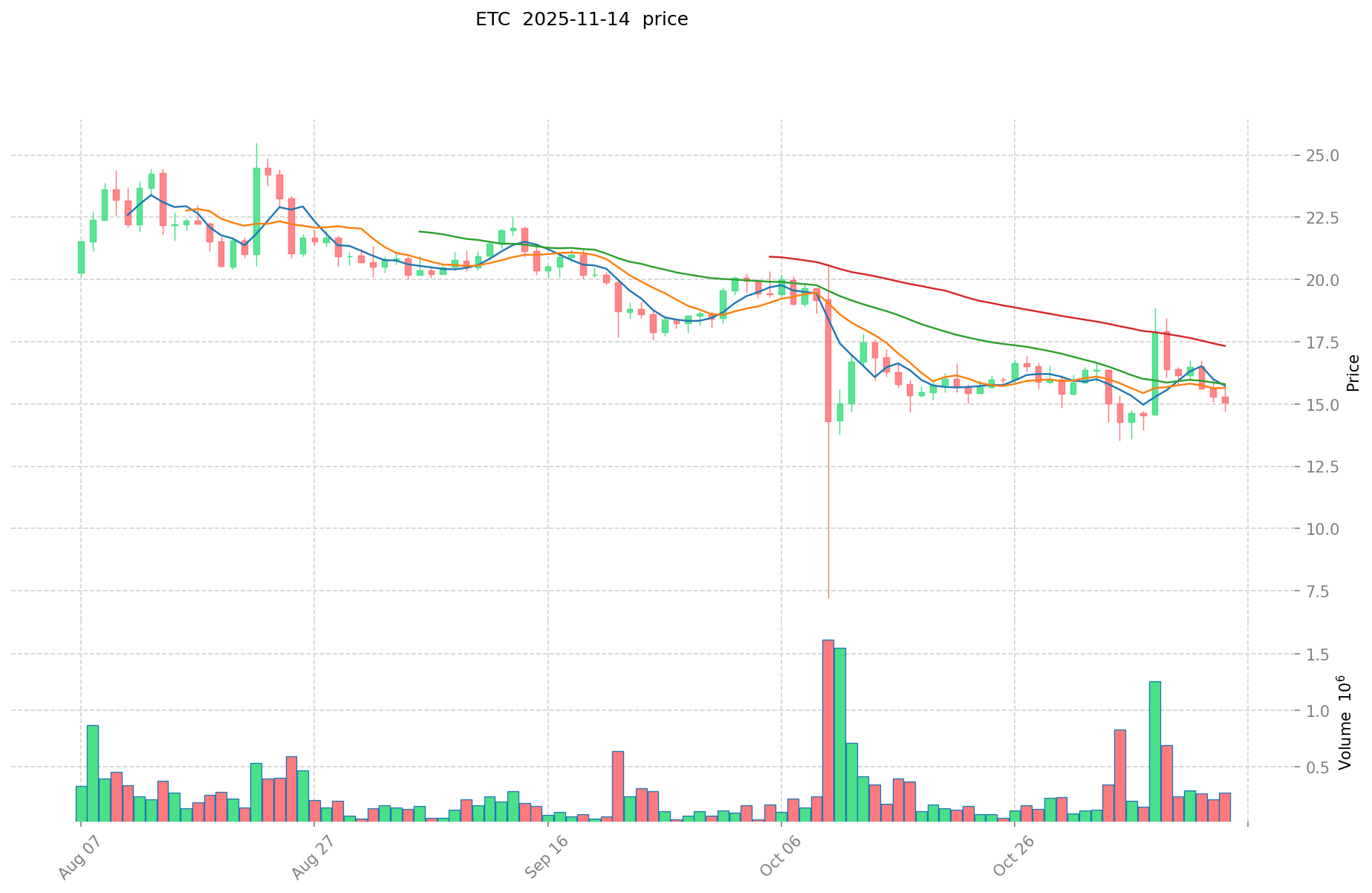WLD vs ETC: Which Cryptocurrency Offers Better Long-Term Growth Potential?
Introduction: WLD vs ETC Investment Comparison
In the cryptocurrency market, Worldcoin (WLD) vs Ethereum Classic (ETC) comparison has been an unavoidable topic for investors. The two not only show significant differences in market cap ranking, application scenarios, and price performance, but also represent different positions in the crypto asset landscape.
Worldcoin (WLD): Since its launch in 2023, it has gained market recognition for its aim to provide global economic access through a decentralized system.
Ethereum Classic (ETC): Introduced in 2016, it has been hailed as the continuation of the original Ethereum blockchain, upholding the "code is law" principle.
This article will comprehensively analyze the investment value comparison between WLD and ETC, focusing on historical price trends, supply mechanisms, institutional adoption, technological ecosystems, and future predictions, attempting to answer the question investors care most about:
"Which is the better buy right now?"
I. Price History Comparison and Current Market Status
WLD and ETC Historical Price Trends
- 2024: WLD reached its all-time high of $11.968 on March 10, 2024, due to significant market interest.
- 2025: ETC experienced a decline, with its price dropping to $15.042 by November 15, 2025.
- Comparative Analysis: In the recent market cycle, WLD fell from its peak of $11.968 to a low of $0.25 on October 10, 2025, while ETC showed relative stability, maintaining a price above $15.
Current Market Situation (2025-11-15)
- WLD current price: $0.7332
- ETC current price: $15.042
- 24-hour trading volume: WLD $5,389,118.16 vs ETC $5,901,667.61
- Market Sentiment Index (Fear & Greed Index): 16 (Extreme Fear)
Click to view real-time prices:
- Check WLD current price Market Price
- Check ETC current price Market Price


II. Core Factors Affecting the Investment Value of WLD vs ETC
Supply Mechanism Comparison (Tokenomics)
- WLD: Total supply of 10 billion tokens, with 70% of tokens allocated to the World ID ecosystem.
- ETC: Fixed supply with a maximum cap of 210.7 million coins, following a deflationary model similar to Bitcoin.
- 📌 Historical pattern: ETC's capped supply mechanism has historically created scarcity-driven price movements, while WLD's value is more tied to ecosystem adoption and utility.
Institutional Adoption and Market Applications
- Institutional holdings: ETC has gained recognition from traditional crypto investment vehicles, while WLD is backed by prominent venture capital firms focused on decentralized identity solutions.
- Enterprise adoption: ETC serves as a store of value and smart contract platform, whereas WLD is primarily utilized within the World ID ecosystem for identity verification and sybil resistance.
- Regulatory attitudes: ETC faces the traditional regulatory scrutiny of proof-of-work cryptocurrencies, while WLD operates in the emerging regulatory landscape of digital identity systems.
Technical Development and Ecosystem Building
- WLD technical upgrades: Focus on biometric authentication, privacy-preserving verification, and expansion of the World ID protocol for global identity verification.
- ETC technical development: Maintains the original Ethereum vision with focus on security, decentralization and immutability following the "code is law" philosophy.
- Ecosystem comparison: ETC supports smart contracts and DApps but has a smaller ecosystem than Ethereum, while WLD is specifically designed for identity verification applications across various platforms.
Macroeconomic Factors and Market Cycles
- Performance in inflationary environments: ETC shares some characteristics with digital gold narrative due to fixed supply, while WLD's value proposition is less correlated with inflation hedging.
- Macroeconomic policy impacts: ETC price movements show greater correlation with broader crypto market trends and monetary policy changes, while WLD may be more insulated due to its specific utility focus.
- Geopolitical factors: ETC offers censorship-resistant transactions, while WLD addresses global identity verification challenges that transcend borders. III. 2025-2030 Price Prediction: WLD vs ETC
Short-term Prediction (2025)
- WLD: Conservative $0.47 - $0.73 | Optimistic $0.73 - $0.78
- ETC: Conservative $11.42 - $15.02 | Optimistic $15.02 - $20.13
Mid-term Prediction (2027)
- WLD may enter a growth phase, with estimated prices of $0.55 - $1.04
- ETC may enter a bullish market, with estimated prices of $15.67 - $29.65
- Key drivers: Institutional capital inflow, ETF, ecosystem development
Long-term Prediction (2030)
- WLD: Base scenario $0.63 - $1.12 | Optimistic scenario $1.12 - $1.32
- ETC: Base scenario $19.55 - $32.59 | Optimistic scenario $32.59 - $38.78
Disclaimer: This analysis is for informational purposes only and should not be considered as financial advice. Cryptocurrency markets are highly volatile and unpredictable. Always conduct your own research before making investment decisions.
WLD:
| 年份 | 预测最高价 | 预测平均价格 | 预测最低价 | 涨跌幅 |
|---|---|---|---|---|
| 2025 | 0.775602 | 0.7317 | 0.468288 | 0 |
| 2026 | 0.85916214 | 0.753651 | 0.68582241 | 2 |
| 2027 | 1.0402644753 | 0.80640657 | 0.5483564676 | 9 |
| 2028 | 0.960268943556 | 0.92333552265 | 0.480134471778 | 25 |
| 2029 | 1.29968708168214 | 0.941802233103 | 0.72518771948931 | 28 |
| 2030 | 1.322478695723232 | 1.12074465739257 | 0.627617008139839 | 52 |
ETC:
| 年份 | 预测最高价 | 预测平均价格 | 预测最低价 | 涨跌幅 |
|---|---|---|---|---|
| 2025 | 20.12814 | 15.021 | 11.41596 | 0 |
| 2026 | 24.7801437 | 17.57457 | 12.4779447 | 16 |
| 2027 | 29.64829959 | 21.17735685 | 15.671244069 | 40 |
| 2028 | 32.7825484038 | 25.41282822 | 22.871545398 | 68 |
| 2029 | 36.081133506756 | 29.0976883119 | 19.786428052092 | 93 |
| 2030 | 38.78139898210032 | 32.589410909328 | 19.5536465455968 | 116 |
IV. Investment Strategy Comparison: WLD vs ETC
Long-term vs Short-term Investment Strategies
- WLD: Suitable for investors focused on decentralized identity solutions and ecosystem potential
- ETC: Suitable for investors seeking stability and inflationary hedge properties
Risk Management and Asset Allocation
- Conservative investors: WLD: 20% vs ETC: 80%
- Aggressive investors: WLD: 60% vs ETC: 40%
- Hedging tools: Stablecoin allocation, options, cross-currency portfolios
V. Potential Risk Comparison
Market Risks
- WLD: High volatility due to newer project status and evolving use cases
- ETC: Susceptibility to broader cryptocurrency market trends and sentiment
Technical Risks
- WLD: Scalability, network stability, and adoption of biometric authentication
- ETC: Hash rate concentration, security vulnerabilities
Regulatory Risks
- Global regulatory policies may have differing impacts on both assets, with WLD potentially facing scrutiny over privacy concerns and ETC dealing with traditional cryptocurrency regulations
VI. Conclusion: Which Is the Better Buy?
📌 Investment Value Summary:
- WLD advantages: Innovative identity verification system, backed by prominent VCs, potential for widespread adoption
- ETC advantages: Established history, fixed supply mechanism, smart contract functionality
✅ Investment Advice:
- Novice investors: Consider a small allocation to WLD for exposure to innovative technology, with a larger portion in ETC for stability
- Experienced investors: Balanced approach with a slight overweight towards WLD for growth potential
- Institutional investors: Strategic allocation to both, with WLD for future-oriented identity solutions and ETC for blockchain fundamentals
⚠️ Risk Warning: The cryptocurrency market is highly volatile, and this article does not constitute investment advice. None
VII. FAQ
Q1: What are the main differences between WLD and ETC? A: WLD is a newer cryptocurrency focused on decentralized identity solutions, while ETC is an established blockchain that continues the original Ethereum vision. WLD has a total supply of 10 billion tokens, whereas ETC has a fixed supply cap of 210.7 million coins. WLD's ecosystem revolves around identity verification, while ETC supports smart contracts and decentralized applications.
Q2: Which cryptocurrency has shown better price performance recently? A: As of November 15, 2025, ETC has shown relatively better price stability, maintaining a price above $15. WLD, on the other hand, experienced significant volatility, falling from its all-time high of $11.968 in March 2024 to a low of $0.25 in October 2025, before recovering to $0.7332.
Q3: How do the supply mechanisms of WLD and ETC differ? A: WLD has a total supply of 10 billion tokens, with 70% allocated to the World ID ecosystem. ETC follows a deflationary model similar to Bitcoin, with a fixed maximum supply of 210.7 million coins.
Q4: What are the key factors affecting the investment value of WLD and ETC? A: Key factors include supply mechanisms, institutional adoption, market applications, technical development, ecosystem building, and macroeconomic factors. WLD's value is tied to ecosystem adoption and utility, while ETC's value is influenced by its scarcity and established position in the crypto market.
Q5: What are the long-term price predictions for WLD and ETC? A: By 2030, WLD is predicted to reach $0.63 - $1.32 in base and optimistic scenarios, respectively. ETC is forecasted to reach $19.55 - $38.78 in base and optimistic scenarios, respectively. However, these predictions are subject to market volatility and should not be considered as financial advice.
Q6: How should investors allocate their portfolio between WLD and ETC? A: Conservative investors might consider allocating 20% to WLD and 80% to ETC, while aggressive investors might opt for 60% WLD and 40% ETC. The allocation should be based on individual risk tolerance and investment goals.
Q7: What are the potential risks associated with investing in WLD and ETC? A: Risks include market volatility, technical vulnerabilities, and regulatory uncertainties. WLD faces risks related to scalability and adoption of its biometric authentication system, while ETC may be susceptible to hash rate concentration and security vulnerabilities. Both cryptocurrencies are subject to evolving global regulatory policies.
Share
Content